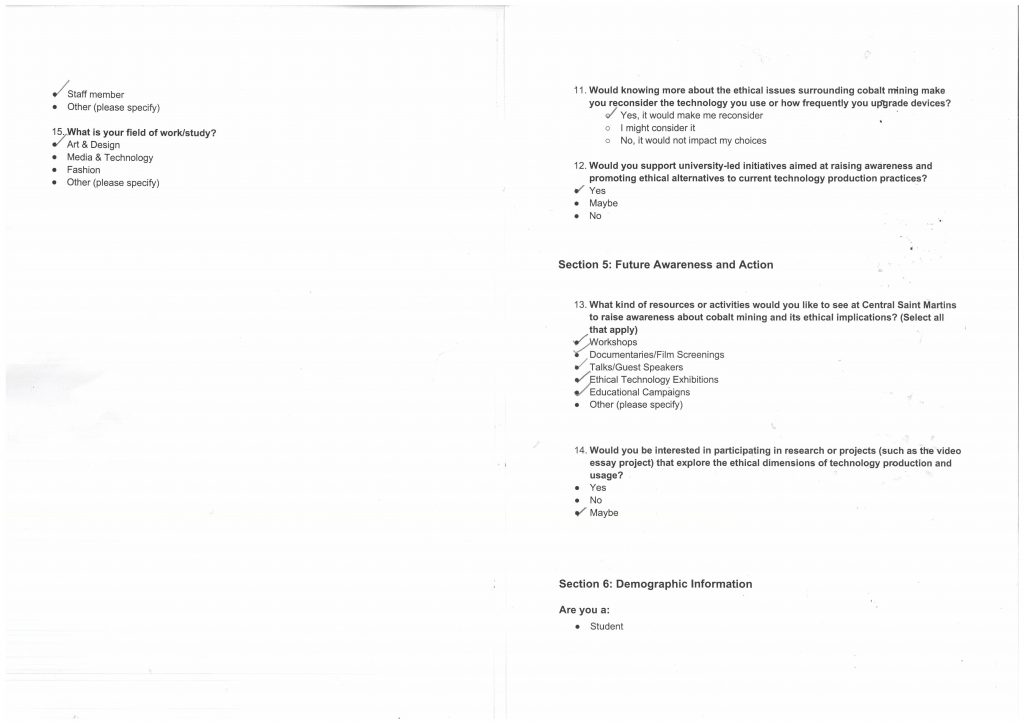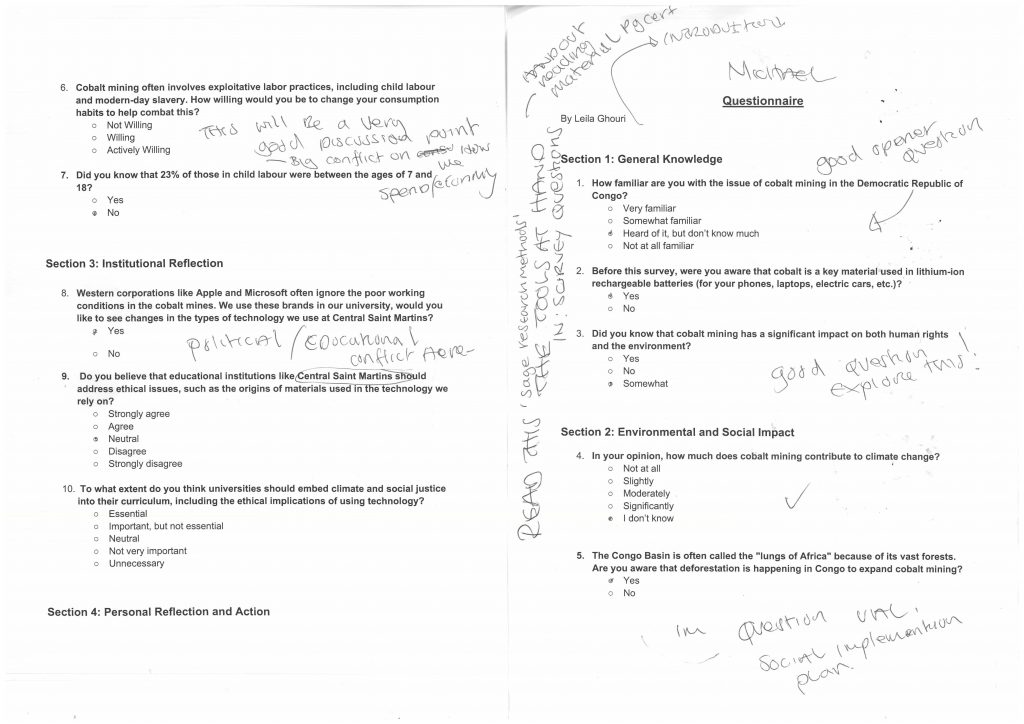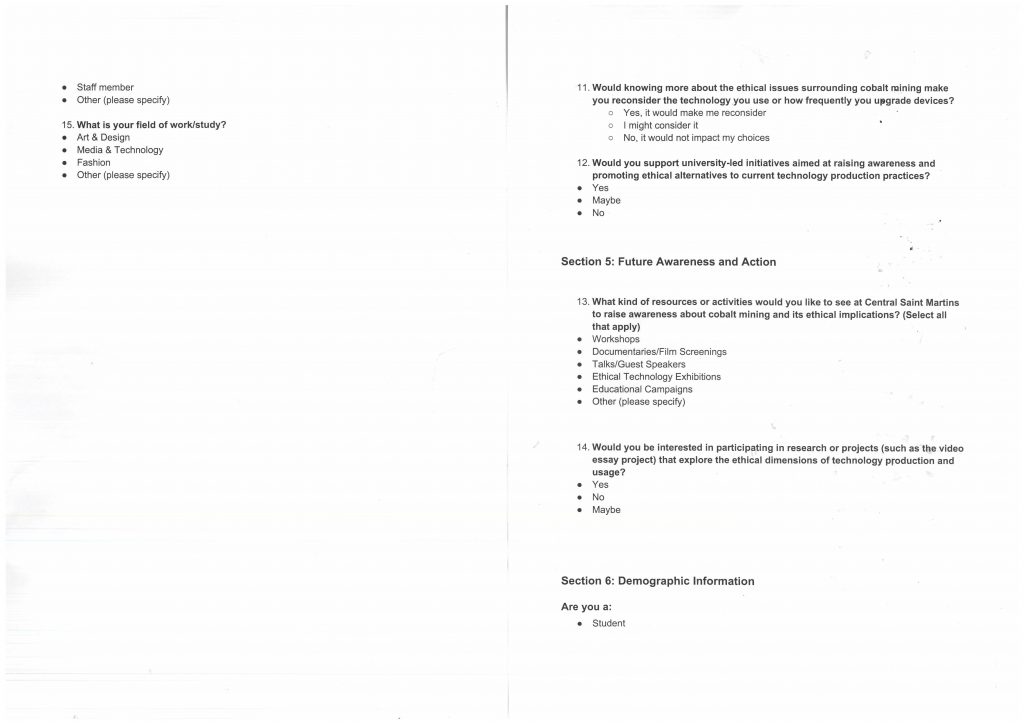On October 25th, I attended a taught Action Research Project session where I sought to refine the design of my questionnaire, a task I have been struggling with. Recognising the value of peer feedback, I came prepared with printed drafts outlining the types of questions I planned to include. This allowed my peers to engage directly with the content, providing written notes or offering verbal suggestions during our discussions.
Designing an effective questionnaire is both a science and an art, as I’ve discovered while exploring ways to assess student and staff awareness of video essays as a tool for disseminating information about cobalt mining at UAL. Drawing inspiration from the seminal work of Krosnick and Presser (2009), I intend to create a questionnaire that not only gathers useful data, but does so ethically and accurately.
At its core, a questionnaire must use clear, specific language, avoiding ambiguity, technical jargon, or leading questions that might bias respondents. These principles are particularly relevant when addressing a complex issue like cobalt mining, where the ethical dimensions of resource extraction and media representation must be communicated clearly. For my project, ensuring that participants fully understand the questions about video essays as a medium is vital to gaining reliable insights into their perceptions, and awareness about cobalt mining.
Another key takeaway from Krosnick and Presser’s guidance is the importance of rating scales. They recommend scales with 5-7 points, which balance ease of use with reliability. I plan to implement such scales in my survey, especially when asking respondents to rate their familiarity with video essays or their perceived effectiveness for advocacy. This aligns with their insights on optimising responses while avoiding biases like acquiescence, which can occur if questions aren’t carefully balanced.
Pre-testing my questionnaire, much like storyboarding a video essay, is an indispensable step in ensuring clarity and impact. During the session, I tested an early draft with a small group of staff members to refine the phrasing, tone, and flow of the questions. The feedback I received was insightful but candid—many questions were seen as overly directional, insufficiently varied, and at times even leading. Initially, I had want to find out what staff and students knew and this would inform my Video Essays subjects covered. My peers in the ARP session further expanded on these points, offering valuable suggestions for diversifying the questions to better capture nuanced responses.
Once finalised, the questionnaire will be accessible to UAL staff and students through Microsoft Forms. Nonetheless, printing the pre-test draft on paper proved an effective choice, allowing for immediate reactions and detailed feedback. This format encourages thoughtful engagement, with participants either annotating directly on the drafts or sharing their insights in person.
During the session, my tutor John O’Reilly offered a particularly valuable perspective, reminding me that it’s acceptable—even beneficial—to narrow the scope of my research. This has prompted me to reconsider the scale of my project, focusing more specifically on the effectiveness of video essays as a medium, alongside the core issue of cobalt mining. To further enhance the questionnaire, I plan to add a concise introductory paragraph to provide context for respondents, ensuring they understand the purpose of the research from the outset.
This process has been both challenging and rewarding, reaffirming the importance of collaboration, clarity, and ethical responsibility in producing impactful academic work.
below I have attached some forms with feedback attached.




Krosnick, J. A. and Presser, S., 2009. Question and Questionnaire Design. In: J.D. Wright and P.V. Marsden, eds. Handbook of Survey Research. 2nd ed. San Diego, CA: Elsevier.
Saris, W. E., Revilla, M., Krosnick, J. A. and Shaeffer, E. M., 2010. Comparing Questions with Agree/Disagree Response Options to Questions with Item-Specific Response Options. Survey Research Methods, 4(1), pp. 61-79.
Taherdoost, H., 2022. Designing a Questionnaire for a Research Paper: A Comprehensive Guide to Design and Develop an Effective Questionnaire. Asian Journal of Managerial Science, 11(1), pp. 8-16. DOI: https://doi.org/10.51983/ajms-2022.11.1.3087.